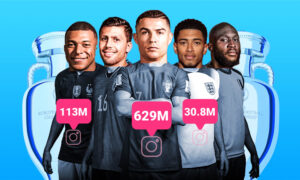Despite the oil market crash, the last few years have seen continued growth in the football transfer market, with emerging football nations growing in importance. United Arab Emirates, Qatar and Saudi Arabia appeared in the top 20 spenders in the Global Transfer Market Report 2015 and 2016, conducted by FIFA TMS.
There is a notable beginning to a shift in the power balance from Western Europe, in favour of emerging football nations across Eastern Europe, China, Asia Pacific, and especially the stand out Middle East.
With billions of fans, a global market worth nearly $30 billion, and a new generation of spendthrift owners, Middle East football has become a conspicuous-consumption game. Competition for top foreign players intensifies by the year. During this summer’s transfer market, outlays from the top five leagues in the Middle East surpassed $200 million.
In United Arab Emirates alone, Arabian Gulf League clubs spent over $50 million last summer on 81 players, out of which 26 players were of Brazilian nationality.
In Saudi Arabia, the Saudi Pro League has a much bigger market compared to the UAE and Qatar for football, determined by their high average fans attendance, revenues from broadcast rights; which were secured by free-to-air satellite broadcaster MBC for the Saudi Arabian Professional Football League and the King’s Cup, in a ten-year deal worth over $1 billion.
Saudi Arabia spent a total of $31 million last transfer market on 72 players out of which 14 players were of Brazilian nationality.
Qatar Stars League side Al Arabi was the eighth-placed club inside the top 10 spenders in the 2014 summer transfer market. The Doha-based club stood out and spent close to $50 million alone on five new players.
Brazil has been the most active country in the international football transfer market and transfers to the Middle East since 2010. Brazilian players have also been the most transferred players in the international transfer market between 2010 and 2016 with 5,826 transfers worldwide (13% of the total). The second most traded nationality (Argentinian) recorded 2,932 transfers during the same period.
Since 2009, it has been tough for economies across the world, with shrinking global finances and falling media/ advertising revenues in all regions, from developed markets such as Europe to emerging markets in the MENA region. But mobility dynamics has been changing, with emerging footballing nations becoming increasingly attractive destinations.
Football leagues in Saudi Arabia, the UAE and Qatar have all been stand out and recognized as top-10 leagues in the Asia-Pacific region by the region’s highest footballing body, the Asian Football Confederation (AFC).
Increasing professionalism, driven by the AFC, mandates an adherence to strict criteria across the board, from league organisation to club governance and transparency.
This offers an increasingly firm ground for investment. The opportunity to maximize income from diverse revenue streams such as match day tickets, broadcasting, sponsorship and merchandising, represents additional earnings potential. As much as it sounds achievable on paper, so far in reality, it has been far from it.
But Middle Eastern teams don’t necessarily get great value for their transfer fees. Much is wasted on the wrong players or perhaps on players who are at the end of their ‘peak years’. As history suggests in the UAE football league, there has always been low correlation between transfer spending by clubs and end-of-season rankings.
The main reason for this, is that transfer activity at Middle Eastern clubs or anywhere around the world for that matter, is governed by ‘animal spirits’ (instincts, emotions, etc.), not rational strategy. Club officials shell out on superstar names to appease fans, and to get media attention– especially strikers – that are overvalued year after year.
There was an increase of 30 per cent in club intermediary commissions paid, specifically to agents but a decrease in the actual number of transfers involving intermediaries, as per the FIFA TMS report.
Middle Eastern investors and Russian oligarchs buy up clubs in Europe and pump outside funds into their squads. In 2010, UEFA passed Financial Fair Play rules “to introduce more discipline and rationality in club football finances.” Clubs are supposed to break even based only on their “football income,” an apparent effort to counter big transfer spending underwritten by Emirati and Qatari petrodollars.
It would be interesting to see if Asian Football Confederation would follow UEFA and introduce ‘Financial Fair play’ rules for Asian and Middle Eastern clubs. There is a long way for the AFC to conclude to such measures, as most clubs in the Middle East do not have a proper revenue stream and are budgeted by the Football Associations, Sports Councils and owners.
















